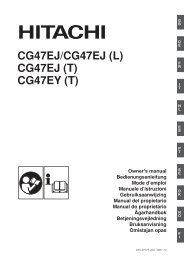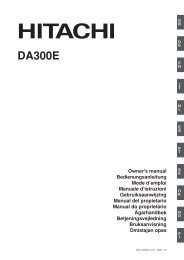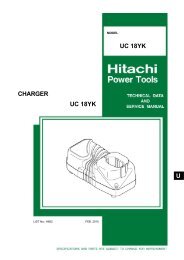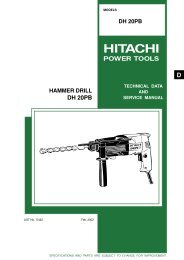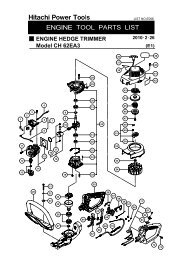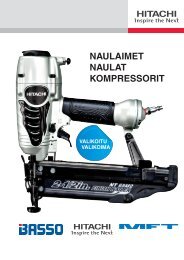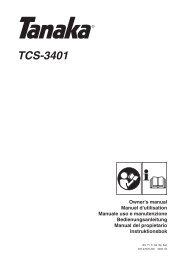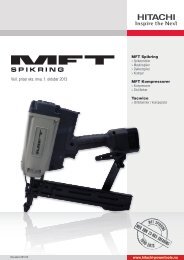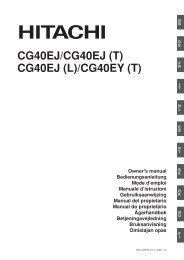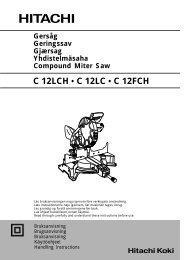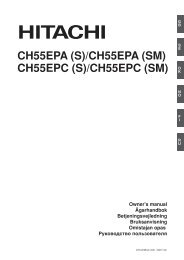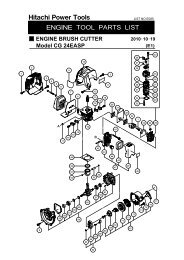CS35EK/CS38EK CS40EK/CS45EK CS33EL/CS38EL ... - Hitachi
CS35EK/CS38EK CS40EK/CS45EK CS33EL/CS38EL ... - Hitachi
CS35EK/CS38EK CS40EK/CS45EK CS33EL/CS38EL ... - Hitachi
Create successful ePaper yourself
Turn your PDF publications into a flip-book with our unique Google optimized e-Paper software.
Fig.2-7G<br />
Fig.2-7H<br />
Fig.2-7J<br />
Fig.2-7M<br />
LIMBING<br />
Limbing is removing the branches from a feller<br />
tree.<br />
WARNING!<br />
A majority of kickback accidents occur during<br />
limbing.<br />
Do not use the nose of the guide bar. Be<br />
extremely cautious and avoid contacting the<br />
log, other limbs or objects with the nose of the<br />
guide bar. Be extremely cautious of limbs<br />
under tension. They can spring back towards<br />
you and cause loss of control resulting in<br />
injury. (Fig. 2-7G)<br />
Stand on the left side of the trunk. Maintain a<br />
secure footing and rest the saw on the trunk.<br />
Hold the saw close to you so that you are in<br />
full control of it. Keep well away from the chain.<br />
Move only when the trunk is between you and<br />
the chain. Watch out for spring back of limbs<br />
under tension.<br />
LIMBING THICK BRANCHES<br />
When limbing thick branches, the guide bar<br />
may get pinched easily. Branches under<br />
tension often snap up, so cut troublesome<br />
branches in small steps. Apply the same<br />
principles as for cross cutting.<br />
Think ahead and be aware of the possible<br />
consequences of all your actions.<br />
Fig.2-7K<br />
CROSS CUTTING/BUCKING<br />
Before starting to cut through the log, try<br />
to imagine what is going to happen. Look<br />
out for stresses in the log and cut through<br />
it in such a manner that the guide bar will<br />
not get pinched.<br />
Fig.2-7N<br />
CROSS CUTTING LOGS, PRESSURE ON<br />
TOP<br />
Take a firm stance. Begin with an upper<br />
cut. Do not cut too deeply, about 1/3 of<br />
the log diameter is enough.<br />
Finish with a bottom cut. The saw cuts<br />
should meet. (Fig. 2-7H)<br />
Fig.2-7L<br />
THICK LOG, LARGER THAN GUIDE BAR<br />
LENGTH<br />
Begin by cutting on the opposite side of the<br />
log. Pull the saw towards you followed by<br />
previous procedure. (Fig. 2-7J)<br />
If the log is lying on the ground make a boring<br />
cut to avoid cutting into the ground. Finish with<br />
a bottom cut. (Fig. 2-7K)<br />
WARNING! KICKBACK DANGER!!<br />
Do not attempt a boring cut if you are not<br />
properly trained. A boring cut involves the use<br />
of the nose of the guide bar and can result in<br />
kickback.<br />
CROSS CUTTING LOGS, PRESSURE ON<br />
BOTTOM<br />
Take a firm stance. Begin with a bottom cut.<br />
The depth of the cut should be about 1/3 of<br />
the log diameter.<br />
Finish with an upper cut. The saw cuts should<br />
meet. (Fig. 2-7L)<br />
THICK LOG, LARGER THAN GUIDE BAR<br />
LENGTH<br />
Begin by cutting on the opposite side of the<br />
log. Pull the saw towards you, followed by<br />
previous procedure.<br />
Make a boring cut if the log is close to the<br />
ground.<br />
Finish with a top cut. (Fig. 2-7M)<br />
WARNING! KICKBACK DANGER!!<br />
Do not attempt a boring cut if you are not<br />
properly trained. A boring cut involves the<br />
use of the nose of the guide bar and can<br />
result in kickback. (Fig. 2-7N)<br />
IF THE SAW GETS STUCK<br />
Stop the engine.<br />
Raise the log or change its position, using a<br />
thick branch or pole as a lever.<br />
Do not try to pull the saw free. If you do, you<br />
can deform the handle or be injured by the<br />
saw chain if the saw is suddenly released.<br />
GB-10



